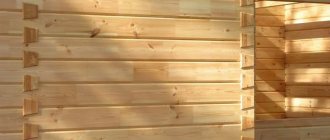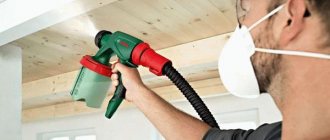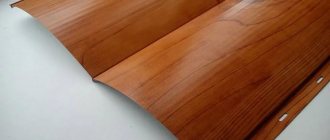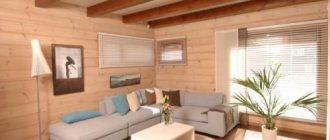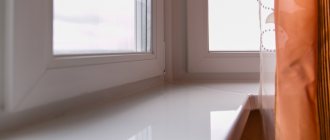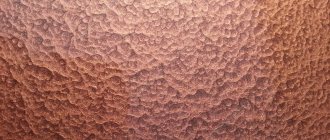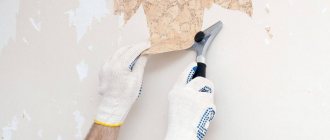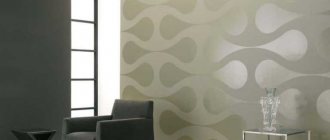Types of lining
Initially, this material was used to decorate the walls of carriages (hence the name). However, for quite a long time, lining has been used to decorate walls inside houses.
Its advantages are widely known - environmental friendliness, aesthetics, accessibility, ease of installation.
Manufacturers offer the following types of lining:
- At quarter. This type does not have a tongue-and-groove fastening system, but has protrusions in the side parts. It allows you to lay the boards overlapping, which creates a rather interesting effect.
- With tongue and groove. This type of lining is usually used for finishing vertical surfaces. It resembles an ordinary tongue and groove board, but smaller in size. Office premises, reception areas are the scope of application of this type of lining.
- “Calm”, “Peasant”, “Russian”, “Simple” are the most popular types of lining. Equipped with a tongue-and-groove locking system, a compensation groove and a flat, perfectly smooth surface.
- The double-sided type has a classic connection system presented on both sides.
- Eurolining. Reminds me of an edged board. A characteristic feature of this type is high-quality processing on each side. The elements are connected to each other using the “groove-tenon” principle. Eurolining is most often made from coniferous trees. The enlarged connection point of this type (up to 8 millimeters) allows you to create a coating without visible seams.
In addition, on the back side of the profile there is a special recess that serves as an air outlet. Thanks to this, condensation, mold and fungi do not appear on the panels.
- "American". It has the shape of an irregular rectangle. There is a groove along the widest part of it, which makes it possible to create an interesting decorative effect - the boards seem to be laid overlapping.
- Block house. This type creates a coating that imitates a structure made from rounded logs. During installation, lathing is used. Creates a heat and sound insulating surface that is not susceptible to splitting or cracking.
- "Finka." This type has an oval or rounded shape.
Each of these types of lining is good in its own way, each is popular. But even the most beautiful coating can get boring and make you want to, if not change it, then at least update it. For this, various coloring compounds, varnishes, impregnations, and so on are used.
Wooden lining is often coated with such substances to extend its service life, emphasize or, on the contrary, hide the structure of natural wood.
Advantages and disadvantages of painting lining
Painting the lining with enamel or colorless varnish can extend the life of the material. If the board is used for covering walls and work surfaces in a utility room, you can get by with regular impregnation.
In a house or apartment, it is better to paint wood paneling with high-quality paint for practical and decorative purposes.
After all, replacing a damaged top layer of wood is much more expensive than several cans of enamel. You can purchase a ready-made painted board or paint it yourself. Coating panels with your own hands has many advantages:
- Possibility of coloring elements in different colors, applying your own design, texture;
- Saving money. Treated lining is much more expensive;
- Possibility to choose the most incredible shade;
- Increasing resistance to negative external factors;
- Quick drying.
It is necessary to paint the lining before installation. During the normal drying process, there will be no light streaks at the joints that spoil the entire look.
There are practically no disadvantages to painting lining. The main negative point is the loss of the natural pattern and appearance of the wood.
Some negative consequences can be avoided if you take into account the purpose of the room when choosing a paint and varnish material. Oil impregnation and drying oil are not suitable for baths and saunas. It is better to use solid mixtures with the addition of wax. It is not recommended to use flammable, toxic enamels for painting wooden boards in closed, unventilated areas. Painting lining floors should be carried out taking into account the abrasion of the material.
To avoid having to repaint frequently, you should choose mixtures with high wear resistance.
Renewing old sheathed walls
There are several update methods:
- Paint it.
- Plaster with sandpaper, then cover with acrylic.
- Paint with varnish.
Varnishing is the most common processing method. Wood is often used in construction, so polishing is a natural way to make your home look beautiful and extend its life. The varnish coating improves the condition of the entire finishing material.
Before you start painting, you need to determine the concept of the interior and its color.
Darkened pine paneling is initially coated with an antiseptic and then with oil paint. Acrylic scuba tanks are often used. The material will serve again if it is updated with varnishing. Oil paint will make the coating shiny, but over time it will still lose color and will need updating. Acrylate paint provides resistance to weather conditions. The surface is less susceptible to external destruction. This coating has a service life of up to ten years.
To ensure a uniform color, first stir the paint well and then apply it to the surface.
Important
To understand whether the tone is suitable, you need to make a test stroke on the lining. This will let you know if the coating needs to be thinned with white. If you process wood, you must first prime it with an antiseptic. It will help protect the product from fungus, since old materials are prone to rotting.
If the previous owners have already painted the lining, then there is no point in covering it with varnish - the old lining needs to be replaced or coated with new paint (we talked about how to practically and beautifully lining the inside of a room with lining, in this article). The result will look harmonious if the color fits into the interior design. The darkened area and places where the paint has peeled off must be treated. It is better to choose neutral tones, but you can resort to decoration in any color.
In a room at the dacha
- Before work, treat the surface with a primer, then with an antiseptic.
- Dry for two days.
- The boards are mounted, varnished and painted.
It is better not to change the color of the material. You can coat it with varnish - the lining will shine: you get a glossy surface. Acrylate varnishes are used for interior work, which preserves the color of wood and protects it from fading in the sun.
In the bath and steam room
There is no need to use regular wood varnish, as it is sensitive to high temperatures.
It is recommended to use imported and protective products. Protective anti-varnish is suitable for treating surfaces in baths and steam rooms. Antivarnish can be colorless or tinted. The coating is applied in two layers. The first one, if it is tinted, is diluted with water to twenty percent. If the composition is colorless, the action is skipped. The second layer is applied continuously. To see how the product applies to the lining, it is better to apply it to a separate board.
The treated surface almost does not absorb water, which increases its service life. The composition contains antifungal components. The product does not emit toxic fumes and is safe.
How to apply Aqualak:
- First, completely clean and plaster the surface. If a protective varnish has already been applied, the wood must first be sanded. This will help avoid contact of funds.
- Apply the first coat with a roller or brush.
- After forty minutes, apply a second coat. If the drying time exceeds 40 minutes, and the surface is completely dry, then when applying you need to rub the material into the wood.
Re-treatment can be done after three to four years.
Read about how to properly clapboard walls in a bathhouse here.
Inside the house
Stages of painting inside the house:
- Clean and prepare the paneling.
- Degrease the surface. Use an alkaline solution.
- Sand the wood with pumice.
- Color. Apply with a brush in a thin layer. To avoid drips, paint from top to bottom.
After processing, you can start decorating (you can see the best ideas and options for decorating walls with clapboard here).
Solutions used for coloring
There are many means for covering lining. These are compositions for internal and external cladding of premises. They differ in composition, speed and quality characteristics.
For example, a wooden exterior façade is affected by ultraviolet rays, moisture, high and low temperatures, so the finishing coating should contain the predominant majority of protective components.
You can decorate the lining of the interior of the house with ordinary enamels and paints. Painted natural boards have an original appearance. Each mixture after painting gives a certain effect to standard lining.
The choice of solution depends on the preferences of the owner of a country or city building.
General recommendations
How to paint a wooden house from the inside? Every homeowner has asked this question at least once in their life. Painting a log house is not an easy task. Many owners, doing this themselves, skip the preparatory stage and immediately proceed to painting.
Because of this error, various troubles with painted surfaces are possible, for example, wood rotting and the appearance of parasites in it. You need to paint the wood according to the above description. Therefore, painting timber and timber houses will take a lot of time and effort.
Paint for the interior decoration of a wooden house must be environmentally friendly, dry quickly and have no odor. The decorative finishing of a room, as well as its design, directly depends on the correct choice of this material. When choosing paint, carefully study the labels and consult with store clerks.
Painting tips (1 video)
Protective agents: properties and application technology
Proper and timely use of protective equipment allows natural lining not to lose its appearance and original structure for many years. Antiseptic agents can increase the moisture resistance and durability of the material.
The solutions also prevent damage by insects, various microorganisms, and the formation of mold, which is detrimental not only to the lining, but also to the health of the dacha owners.
Based on the basis of manufacture, antiseptic agents are divided into four main groups:
- Organic solvents. They penetrate deep into the material, destroy areas of rot and mold, and prevent the appearance of new ones. Actively combat biological pollution. They have a pungent odor. Can be used indoors and outdoors;
- Water-soluble products. Temporarily protect wood in contact with moisture. Used for preventive purposes;
- Oil antiseptics. It is recommended to treat lining that is in the open air in contact with the ground with moisture. Effectively protect material in difficult conditions;
- Combined mixtures. The solutions contain various substances. Inherent in each group. They cope well with mold, moisture, and high temperatures. Can be used for both internal and external processing.
To reduce the negative impact on the lining, various solutions are used. Bioprotective compounds successfully fight pests, mold, and mildew. Fire retardants provide fire protection and slow down the spread of fire.
Complex protective agents – biopyrenes – are used as a base coating.
To bleach wood, you can use chlorine-containing mixtures, hydrogen peroxide, and special industrial liquids. Lining made from low grades of wood must be treated with primer to fill the pores.
The lining is covered with protective agents before varnishing and decorative treatment.
The application technology consists of impregnating each fragment separately and on both sides. Using a brush or roller, spread the antiseptic over the entire surface in a thin layer. It is necessary to reach all hidden areas (corners, recesses). Wooden boards should dry without touching each other.
Lining profiles
The appearance of the boards and the recesses for connecting them to each other determine the profile of the lining.
The most popular are:
- Eurolining. It looks like a long, narrow board with a groove and tongue on both sides. On the inside it has small gutters for ventilation. Panel width – from 10 cm, length – from 2 m, thickness – 1.2 cm.
- Blockhouse. Under this name lies a lining that imitates round logs; for this purpose, its outer side is made in the form of a semicircle. The profile has the following parameters: length from 2 to 5 meters, thickness - 3.6 cm, width depends on the thickness (9-19 cm). Coniferous trees are used to make boards.
- American. It looks like a wooden beam. The profile is made in the form of a rectangular trapezoid. The thick part, where the thickness is from 2.2 to 4 cm, has a groove, in the narrow part (from 1.4 to 2.8 cm) there is a tongue.
Varnish compositions and their properties
To refresh the antiseptic-impregnated lining and refine the finish, the wood is varnished. The required composition of the solution is selected based on the type and purpose of the room.
- Oil- based resin varnishes can have different shades - from transparent to dark chocolate.
The coating hardens quickly, forming a dense film. The moisture-resistant surface is easy to clean and is completely ready for further painting. The main disadvantage is the high level of fire hazard.
- Alkyd universal solutions have a high level of resistance to external negative factors. They are absorbed deep into the wood, so they take a long time to dry (up to 3 days). Alkyd-urea varnishes have almost identical characteristics. Before use, the solution must be mixed with an acid hardener.
It has a strong shine after hardening. Disadvantage: high price, rapid ignition.
- Alcohol polishes and varnishes are used in minimal quantities to coat individual elements of the lining. Apply a very thin layer of solution using a cotton swab or small brush. The dried coating noticeably shines and gains elasticity. Some types of alcohol mixtures do not tolerate sunlight, so they cannot be used on large areas of the lining.
- The composition of nitrocellulose varnishes includes plasticizers, resins, and pigment. After application to wood, they form a dense protective and decorative coating. They do not cover lining intended for finishing facades. Nitrovarnish does not tolerate sunlight. High temperature.
- polyurethane and acrylic solutions are applied to the lining in several layers due to the high volatility of the mixture. They have surface tension properties and do not crack or wear off. The varnish adheres tightly to the wood, protects it from chemicals and getting wet.
Varnishing
This method is the most popular, as it does not require a lot of time, effort and finances. Alkyd or water-based varnishes reliably protect the coating from external influences, highlight the natural color and pattern of wood, and make the surface vapor-proof.
We suggest you read: Is it possible to plant dill before winter and when: winter sowing in open ground in the fall, how to do it correctly and which varieties are best suited
In addition, modern manufacturers produce products with additives that have bactericidal properties and protect against solar ultraviolet radiation - such compositions will help update the lining on a balcony, veranda or other open area.
Varnishing the walls has one more advantage - the darkened lining will become a unique decorative element when stylizing the room in an antique style.
Paint selection
To paint the lining, you can use various types of coloring compounds. Of course, if the work will be carried out inside a living space, it is better to choose those compounds that do not have a strong odor.
The modern market offers a wide range of different paints:
- Oily. This is a recognized leader among all decorative coatings. Thanks to deep penetration into the surface, the result is reliable protection. This type of paint provides good coverage that remains attractive for a long time. Disadvantages include the presence of a sharp, specific odor and the drying time.
This type of paint is best used outdoors, outside. It is not very suitable for interior decoration.
- Acrylic paints. They dry quickly, do not have a pungent odor, retain their original color for a long time, and are resistant to moisture. Well suited for interior work.
- Acrylic scuba tank. One of the best ways to design lining. This is an environmentally friendly material that provides a strong and durable coating.
- Alkyd varnish. It takes a long time to dry and is highly flammable. But it is insensitive to moisture and temperature changes.
- Glaze. Emphasizes the natural structure of wood. If you add color to it, you can get a colored coating.
- Opaque enamel. Optimal for suburban buildings. Due to the formation of a dense layer, it provides good protection from mechanical stress, damage, and also hides existing defects.
- Water-based. Preserves the wood texture and gives a matte finish. The paint dries quickly and has no odor;
- Silicone. Withstands impressive mechanical loads. It has good vapor permeability and masks defects. Retains color for 30 years;
- Alkyd-based enamel. Suitable for decorating lining. During prolonged drying, it emits a pungent, unpleasant odor. Fades quickly in the sun;
- Wax. Traditional, natural material for processing lining. After painting, it retains the natural pattern of wood, gives a matte, glossy shine;
- Silicate. The composition includes liquid glass, which significantly improves the characteristics of the paint. She is not afraid of ultraviolet rays. A dye with increased fire resistance protects the lining from temperature changes.
Types of water-based paint
Well, now that we have sorted out the necessary properties, let’s see what the modern market offers us? You should know what to choose from and how the contents of these colorful jars differ from each other.
Polyvinyl acetate water-based paint
One of the most budget-friendly is paint based on PVA glue. The product has some pretty bad reviews, but in fact it is much better than its reputation, the main thing is to apply it to the right place.
- It should be remembered that this paintwork only applies to porous surfaces; metal ones are not one of them.
- The second disadvantage of the product is its high hydrophobicity. We would not recommend subjecting a surface treated with PVA paint even to wet cleaning. In this case, as you understand, there is no question of washing the walls.
- Well, the biggest drawback, in our opinion, is the poor color palette. Of course, some craftsmen try to mix paints of different colors in order to get the desired shade, but where can they get the same one if they need it for tinting? After all, you can’t swim in the same river twice.
Fig 5
Scary, right? On the other hand, if you just need to paint even walls in the hall or living room, work near the fireplace (Polyvinyl acetate paint is fireproof), and the finished color is quite satisfactory, then why not? Believe me, there is no point in overpaying.
Water-based acrylic paint
The most common group of paints and varnishes are those made on the basis of acrylic resins.
If the finishing of the walls for acrylic painting was done scrupulously and according to all the rules, then no problems should arise with the use of the surface. Acrylic coating is distinguished by its enviable strength, average moisture resistance and rather poor vapor permeability.
Such average indicators, plus, although not budgetary, but still quite affordable, have made acrylic paints a leader in the market of paints and varnishes. They are used almost everywhere. But still, we would not recommend using it in cellars and basements. Poor vapor permeability of the material will prevent the walls from getting rid of moisture naturally, resulting in the appearance of fungus.
Silicone water-based paint
The highest quality and most expensive paint material today has a silicone base. Yes, that’s understandable. This paint creates a durable elastic layer, has a vapor-conducting effect and is absolutely not afraid of water.
In addition, it is not necessary to lick the surface under the silicone material; it can heal small cracks on its own, which means you can work on “living” surfaces.
If we compare the advantages and disadvantages of this material, then of the latter we can only name the significant cost of the product, which forces us to buy it only in case of emergency.
Silicate water-based paint
Silicate water-based paint is a liquid-based paint. In interior design, let's face it, it is not used often. Still, resistance to aggressive environments is not a quality that is so much in demand in apartment renovations.
But on the other hand, this particular type of paint and varnish material is famous for its exceptional wear resistance and high repair ability. Here you can putty the walls like you would under wallpaper, without bothering with small scratches. And sometimes, above average too. The silicate will tighten everything and even it out.
Textured water-based paint
Very often we come across the concept of “textured paint” in everyday life, that is, one that is used to apply a textured pattern. In fact, only a small percentage of it will contain small abrasive particles, which, in fact, form the texture; for the most part, it will be modified acrylic paint, the properties of which will be most suitable for creating an original wall pattern, but you will have to use a special technique applying paint.
Moreover, this does not mean that the same texture could not be created using an ordinary “water emulsion”. That is, in most cases you can save money on specialized material.
How to calculate the required amount of paint
Any repair or construction must begin with an estimate and detailed instructions. Consumables, such as paint for lining, must be purchased in reserve. When making calculations, one should take into account the characteristics of the surface, tools, professionalism of the work performers, the number of layers and the texture of the mixture.
If the entire room is to be painted, then first of all it is necessary to determine its perimeter.
- We take away the area of doors, windows, openings and other untreated surfaces.
- The result obtained must be compared with the standard consumption of the selected type of paint.
- Manufacturers place this information on the product label.
- You need to understand that the quantity is indicated taking into account the work under ideal conditions, for one layer of painting.
Lining painting technology
Factory-painted lining elements cost several times more than untreated boards. The services of hired workers will also not be cheap. To save money, you can carry out all stages of coating yourself. Fortunately, this is not difficult to do.
Properly selected consumables and auxiliary materials will enliven the interior and fill the house with new colors.
The application of enamel should be carried out after antiseptic procedures, priming and varnishing. When working with any mixture, certain rules must be followed. Only in this case can you count on a positive result.
Artificial aging of lining
If the material was chosen precisely because of the texture of the wood, and not its availability or environmental friendliness, then the option of artificial aging will become interesting to you. This is a complex of painting works that allows you to give the appearance of old, decrepit wood, without losing the positive qualities of the finish.
Painting occurs in several stages:
- Color selection;
- Degree of aging;
- Hand-decorated parts.
The overall color of the lamellas is a background shade that will give the effect of severe aging, burnt wood, etc.
The most popular are dark shades of black and brown. Painting is possible with a roller, brush, or spray gun.
The degree of aging is the quantity and quality of additional effects. They are applied by hand with a sponge or outlined by hand with a small brush. These are inclusions of paint of a similar shade, the creation of artificial rust, etc.
Manual decoration - processing of knots, chips and cracks on the surface of the lining. Requires a serious level of paint handling.
The antique-painted lining in the interior in the photo looks unusually fresh. A separate wall decorated with such material would be a good place to display hunting trophies or a collection of antiques.
Required materials and tools
Even a beginner can paint lining well. It's better to work with new material. It is quite simple to prepare, process and dry. The task becomes more difficult if the boards have already been used and the toning needs to be updated.
Only clean lining can be repainted. The method of removing varnished coating is the same for all types of wood.
It is better to bleach pine and larch in warm and ventilated areas. Painting wooden panels is carried out using a minimal set of tools and materials.
You need to prepare:
- Paint tray;
- Galvanized, plastic bucket;
- Brushes for applying paint of different sizes, roller, spray gun;
- A ladder that allows you to reach the ceiling;
- Solutions for painting (stain, varnish, enamel, primer);
- Tools for stripping, grinding, rubbing (sandpaper, leather flaps, sanding machine and others);
- Wide safety glasses, mask, gloves.
Required Tools
Depending on the paint application technology, the list of tools may vary, but the standard set is as follows:
- paint tray;
- plastic or galvanized bucket;
- pumice;
- clean rags;
- painting tools (roller, brush, spray gun);
- primer;
- skins of different grain sizes, sanders, scraps of leather for rubbing;
- brush;
- protective equipment (goggles, mask, gloves).
If the room is high or the ceiling is lined with clapboard, you need a stepladder.
The better way to apply paintwork
The ideal tool for application is a brush that has smooth, thick and dense bristles.
The flute brush easily applies any paint and varnish materials and makes smooth finishing strokes.
- Due to its large size, wooden bases can only be primed with the Macklova.
- Varnish is easily applied with a brush with soft bristles; to apply oil, on the contrary, you need a tool with stiff bristles to evenly apply the dense mass.
- The shape of the brush should be rectangular with rounded edges to make painting easier. If you bought a low-quality brush with frayed bristles, cut them off with scissors.
- Apply the liquid composition with a brush to a small area. For larger ones, a roller is used.
Rollers are available in different sizes and minimally absorb paint material. Usually the walls are primed with a roller, but with enough experience you can apply tinted oil.
To use a spray gun you need to have skills. An airbrush is used to process any skin, but at the same time clouds of dye droplets rise into the air. The airless model does not pollute the air, but is suitable for painting only straight substrates. Combined airbrushes are optimal, but only specialists can use them. The spray gun also increases paint consumption.
It is convenient to paint the linings with pipes at the junction of boards with a chain-link mitt or a foam sponge.
When choosing a tool, the size of the surface, the type of paint and varnish material and experience with it are taken into account.
What is better to paint
To apply paint to the lining, you can use a brush, spray gun or roller. Choosing the right tool will make the process much easier. For a small area, you can use a wide brush. In this case, the paint should be moderately thick so that there are no noticeable marks from the strokes.
This material can be used to add color to both individual boards and the assembled structure.
It is better to use a roller for covering eurolining and other types of boards with a smooth surface, with unpronounced seams. You can take a wide tool that grabs two boards at once. This will speed up the process and reduce paint consumption.
When using a household spray gun, you must prepare for high consumption of water emulsion. In order for the paint to be better absorbed into the wood, the solution should be made very liquid. With this technology, leaks and layers are inevitable.
It is necessary to strictly maintain the distance between injections to avoid the formation of drops.
Drying and moisture level of the lining
Only high-quality, dry wood can be used for cladding. Wet lining will certainly spread and crack some time after installation. You can determine the degree of humidity at home using the traditional method. The weight of a dry board is significantly different from a wet one.
A mechanical pencil will not leave a purple streak on dry paneling. The sound of dry wood will be louder.
You can resort to traditional methods if you have comparative wet material at hand. If there is nothing to compare with, you can use a mechanical method of verification. It is necessary to drill a hole in the wood to be tested. Hold the cutter in one position for 20 seconds. Visual analysis of the excavation will indicate the approximate moisture content.
The hole began to smoke - the board was overdried, nothing happened - the humidity was normal, a fringe formed - the lumber was damp. The lining must be dried under a canopy in the open air for several months.
It is necessary to thoroughly dry the lining after each treatment (impregnation, priming, varnishing, painting). If these are separate boards, they should be placed in a ventilated area or taken outside in warm weather until completely dry.
The hardening time for each solution used is individually calculated by the manufacturer. The drying time may increase if the paint is applied in several layers.
Choosing paint to paint the lining white
The following types of paints are used to process panels:
- Oily;
- Acrylic;
- Water-based.
Oil paint
It is a mixture of vegetable oils, organic fillers and alkyd resins. The advantage of oil compositions is their high drying speed and resistance to natural factors.
After application, the paint dries within several hours. After drying, it forms a glossy or matte film on the surface. The surface film increases the resistance of the lining to abrasion and damage.
White oil paint is used to paint various elements of buildings and structures. The main disadvantage of oil compositions is the uneven distribution over the surface. Over time, small cracks appear on the surface of the panels. Therefore, oil paints cannot be applied in a thick layer.
Acrylic paint
Acrylic compositions are a mixture of aqueous dispersion and polymer substances. To dilute acrylic, use ordinary water. When dry, it forms a waterproof film. Acrylic paint does not contain harmful or toxic substances.
The advantage of acrylic paints is their high drying speed and uniform distribution over the surface. The freshly applied composition is easily washed off with water. The dried layer is removed using special means.
The disadvantage of acrylic paints is that they darken after drying. White lining loses its whiteness over time. To restore the white color, re-dying is required.
Water-based paint
It is a mixture of water, pigments and polymer particles. For dilution, clean cold water is required. To apply to the lining, a brush, roller or spray is required.
The advantage of the paint is its high drying speed and easy care of the painted surface. The water emulsion is easily removed with warm soapy water.
A significant disadvantage is low moisture resistance. Therefore, water-based paint is used for cosmetic repairs of dry rooms.
Preparatory stages
Proper preparation of the lining for painting makes it easier to work with the material in the future. New dried boards should be cleaned of dirt. If it is very dusty, you can use a damp cloth and baking soda. Then it is necessary to eliminate all defects.
The wood is sanded with pumice or fine sandpaper. Small particles are removed and primer is applied.
If the lining has already been used, preparatory work includes mandatory cleaning of the old coating. Paint and old varnish are removed with solvents. Multilayer dried materials are removed with a metal brush, hairdryer, or construction spatula.
If in the future the old lining will be covered with transparent varnish, then it is better to use a mechanical cleaning method. Solvents and removers can whiten the surface unevenly.
Treat with acrylic
This method is not only fashionable today, but also durable. A surface coated with acrylic will last up to 10 years without renewal. In addition, acrylic paint is easy to use, it dries quickly, has virtually no odor, and through this coating the structure of the wood and its natural shade are visible. True, the price of such a coating is much higher than varnishes and oil paints.
Before painting the surface, we carry out preliminary preparation: if there was paint on the lining and it is in good condition, then just wash the wood with alkali; if there are mold stains or the wood was varnished, then the old coating must be cleaned off. Then coat the surface with an antiseptic and only then paint.
Applying paint
It is easier to paint wooden lining before its installation. The solution should be applied in a thin layer, slowly moving from top to bottom. If a brush is chosen for work, it should have semi-stiff bristles. To avoid streaks, do not put a lot of paint on the brush.
The roller should have medium-length pile.
After dipping it in paint and rolling it along the tray, the tool is pressed against the paneling with moderate force and rolled several times. There should be no voids or smudges on the surface. If the boards have already been assembled, their edges must be painted with a brush. Painting with a spray gun will be faster, but some of the paint will scatter onto nearby objects.
Design
Many home owners prefer not to paint the lining and preserve the natural pattern. But in order to prolong the original appearance, the wood should still be treated, otherwise the walls may darken or acquire a blue tint.
To get rid of the gray tint on wood, you will first have to sand the top layer, and then treat the surface to protect it from sunlight.
It will be more difficult to remove the blue tint - for this you need to use biological agents. Chlorine and active oxygen will help cope with the task. After treatment, the surface must be impregnated with a protective composition, and then painted with thick or translucent paint.
Natural wood shade will not harmoniously complement all interiors, so the walls can be painted.
A large selection of painting methods allows you to create an exclusive coating. To do this, it is important to choose the right paint color. Don’t forget about simple rules: light shades visually expand the space, while dark shades, on the contrary, make the room smaller.
Below are some recommendations and tips that will help you choose the right color.
- Warm and calm shades look great in the kitchen interior: yellow, orange, pink and peach.
- A honey-golden shade combined with a natural wood pattern looks great in the living room. The interior can be diluted with light shades or bright and catchy colors.
- For the office, you can choose natural wood colors. In this case, oak looks great, but the lighting in the room must be well thought out. Cool tones will also help you get into a working mood.
- In the bedroom it is better to use wood shades or light and neutral colors. White also looks great when decorating the walls in the bedroom.
- You can use any colors in a nursery, but psychologists advise against bright and saturated tones - it is better to choose calm and moderately bright shades. They will not only create a special playful mood, but will also help the child relax and get ready for sleep and rest.
Lining painted gray and blue will create a feeling of dampness and cold, so it is wiser to use such shades in sunny rooms.
The lining can be mounted in various ways:
- Vertical. Will allow you to visually raise the ceiling. This technique is especially good to use in combination with light shades.
- Horizontally. Helps visually lengthen the wall and create the effect of expanded space.
- Diagonally. It will create special dynamics in the interior and allow you to make a spectacular accent on the wall or ceiling.
- Alternating. Allows you to create a special charm with a simple technique. For example, you can depict various shapes on the wall: a herringbone, steps and other combinations that the homeowner’s imagination can create.
Maximum naturalness while preserving the pattern
When choosing wood for the interior decoration of an apartment or country house, people often want to surround themselves with the natural texture of wood and do not plan to hide it under thick layers of paint. But finishing is necessary for lamellas not only because of their appearance, but also as a protective layer. In this case, a natural design for painting the lining inside the house will help; photos confirm the safety of not only the texture, but also the design. The easiest way in this case is to use transparent varnishes or azure, which can be applied both to individual lamellas and to the finished finish.
But preserving the natural pattern is also possible with a change in the main color. In addition, special technologies make it possible to enhance the contrast by tinting the grooves and leaving the convex parts lighter. For this purpose, pigmented glazes and oils are used. The coating is applied using brushes and blended with a roller. After 10 minutes, the residue is removed, leaving a lightly colored board with emphasized lines.
How to choose a dye color
- In the living room , it is better to use materials for painting that emphasize the wood texture and give it a golden-honey hue. Additionally, you can use bright, saturated colors in the design.
- In the kitchen , the best paint colors are orange, peach, pink or yellow.
- The office is usually decorated in cool colors or the wood is kept in natural color. The room is sheathed with slats, which are then opened with varnish or wax.
- For children , soft, calm, soothing tones are chosen. You should not choose flashy tones that excite the child’s psyche.
- To paint the bedroom, neutral, light shades or clear varnish are used.
What can you combine with?
Combining lining with other finishing materials is a popular solution that allows you to use wood trim in any room of the house.
Wallpaper. This tandem is used in the living room, bedroom, nursery, kitchen and even bathroom. Typically, panels occupy ⅓, ⅔ or half the height of the wall from the bottom. Improve the transition between them with molding or wooden plank. To achieve visual harmony, paint the lining in one of the shades that is present on the wallpaper.
Ceramic tile. A wonderful duet for the bathroom, toilet and kitchen. Paint the wood the same tone as the tiles for a small room, or use contrast for a large one. A bathroom made of natural-colored clapboard and white tiles looks ultra-modern and fresh.
The photo shows a dark set with bright accents
Stone. On the one hand, the union may seem unusual, but nature itself dictates it. Smooth slabs with wood are used in wet rooms, textured ones in the living room or kitchen.
Brick. A white brick-wood wall will appeal to fans of Scandinavian design, while dark patinated wood with red brick is perfect for a loft.
Lining painting techniques
- Brushing. Painting option for soft wood. First, remove their top layer with a coarse brush, then the surface is sanded and covered with stain.
- Patination. Two colors similar in tone are used. First, a thick layer of the first shade is applied to the wood and dried. Then a second lighter one is applied and also dried. The surface is sanded.
- Paraffin coating. Gives the surface abrasion. Paraffin is applied unevenly, then the lining is patinated. After drying, the paraffin is removed with a spatula. The surface is opened with stain.
- Bleaching. The base is covered with acrylic pigment or stain, and a layer of oil is applied on top. For a beautiful design, excess dye is removed and the surface is rubbed. The technique is used for painting white while maintaining the texture of the lining. When applying stain, do not pour too much mixture.
To get the desired shade, it is better to paint in several very thin layers, each of which is given time to dry completely.
- Furniture painting. First, the stain is applied, then the surface is primed twice. When the soil dries, the lining is sanded several times. To obtain a matte finish, the lamellas are first sanded with 280 and then 320 grit sandpaper. After removing the sanding dust, the wood is varnished.
Covering for lining
Modern manufacturing companies offer their customers finishing materials made from a wide variety of tree species. The starting materials can be either expensive types of wood or budget options acceptable to most clients, such as pine. Expensive and valuable species should not be painted, and this is usually not done, but lining made from budget tree species is painted or stained at the request of the manufacturer and client.
Interior in Art Nouveau style with black lining in the hallway
The owner decides what is best to paint the lining. Some people prefer paint, others prefer varnish: it all depends on the result the person wants to achieve. A fairly common option is when you choose white color, since painted white lining is a kind of universal solution, and it will easily fit into any interior style, regardless of whether it is a residential, commercial or technical premises.
Light gray lining in a nautical style bedroom
How to paint lining like bleached oak
Often it is necessary to paint the wood white, but so that the veins are visible. They also say to create the effect of bleached oak. There are several ways:
- Use tinting with the appropriate name, which is also called stain. Different manufacturers have these.
They usually have the names "frost", "bleached oak" or something like that. Application feature: do not pour too much composition. If you overfill it, the surface will begin to peel off over time. To achieve the desired degree of coloring, apply several very thin layers. After each, give it time to dry thoroughly.
- Oil with wax with a similar name. The application technique depends on your desire: one or two layers for an almost opaque coating, or one layer followed by rubbing with a rag for a pronounced texture.
- Pigmented polyurethane primer called “white” or “bleached”. To obtain a translucent coating, the composition is diluted with a large amount of thinner. Its amount can be 80-100% of the volume (determined by samples). The disadvantage, like all polyurethane paints and varnishes, is that they turn yellow over time.
- Pigment acrylic primer , also diluted by 80-100%. The color remains white for a long time, but this primer costs more than polyurethane.
It’s hard to say which composition to choose - you need to try
It is advisable to paint the lining with several compounds and compare the results. The effect when using different products is slightly different, but it also greatly depends on the wood. The reviews are also very different - some whitened with tinting, others with oil. Soils are rarely used for these purposes, but mainly because not everyone knows their properties.
Painting the walls. Ideas
- The most unexpected materials, mesh, tulle, massage hair comb and even a bouquet of feathers give very original effects!
- Nowadays it is fashionable to design the main accent wall in a space. You can use the effect of aging and water leaks. Blots, stains and paint stains on the wall look unusual.
- Using a long bristled brush, you can create the effect of striped walls.
- An unusual pattern is obtained if you make masks with a medium-bristled brush crosswise, overlapping one stroke onto another.
- Try using a brush to make splashes of different colors on a plain background. It will turn out unusual, and it will be fun!
- Chaotic brush masks will also look unusual on the surface.
- Apply paint to the surface using a sponge using blotting movements; the pattern depends on what pores the sponge has.
- If you apply paint to the surface of the wall using a sponge, a marble effect will appear.
- Create a grainy effect using a regular clothes brush.
- Using a crumpled rag and paint, the effect of Venetian plaster is created.
- Roll the rag around the roller and paint the wall. The imprint that this design will leave will delight you with the unusualness and creativity of the design.
- Try making patterns on the wall surface using a rag that is scrunched or twisted.
- Slate paint is used to paint the walls. This paint allows you to effortlessly remodel the space depending on your mood. On walls covered with this paint you can write and draw pictures with chalk.
- Another new product for this period of time is marker paint. On the surface coated with this paint you can write and draw with dry erase markers. This technique allows you to draw and erase images depending on your wishes.
- Use stencils for decoration. You can buy them at hardware stores or cut them yourself from thick paper.
- The stencil can be attached to a roller if the dimensions of the stencil allow, and in this way you will again get an unusual effect on your wall.
- Attach the bubble wrap to the roller and paint the wall. You will be pleased with the result.
- Draw various designs on the walls. It could be something very serious and complex or simple children's drawings like.
- Transform your space. Make contrasting patterns on the wall.
- A wall decorated with prints of yours or your children’s hands will also look new. You can mix paints and make prints of different colors.
What color should I paint the walls? Use different shades of the same color and those shades that are related to each other.
How do you find our ideas? Or maybe you can share your ideas with us?
Secrets of decorative wood staining: techniques and tricks
City dwellers want to preserve the natural color of wood as much as possible. For those for whom wood in the house is a boring everyday thing, paint the interior lining in some unusual color.
Modern paintwork materials allow you to achieve different effects. For example, textured or brushed lining, but in two colors. This technique is often used in loft style interiors.
The trick is to apply two layers of different colors. The first layer is a dark color, the second is a light or brighter color.
Painting in two colors may not be the same. You can make the recesses a darker color, and only slightly tint the face (front part) or do everything exactly the opposite. The result is a striped wall made of clapboard - the effect of a slatted wall.
The final stage of finishing is varnishing
There are several types of varnishes that correspond to the task in the interior - these are, first of all, transparent (Pinjalac 20), or tinted (Pinja Satin) semi-matte varnish. Thanks to them, a protective and durable coating is created, providing long-lasting protection from both moisture and mechanical damage.
Painting with opaque compounds
If there is a need to paint wood with an opaque coating in different colors, then it is important to use:
- Waterborne acrylic primer Pinja Surf,
- Pinja Star semi-gloss acrylate topcoat paint.
Advice. In order for the final layer to lay on the wood more evenly, it is necessary to apply a primer or paint before the final painting or varnishing. In this way, you can easily achieve the effect of evenly applying the finishing paint with less material consumption.


